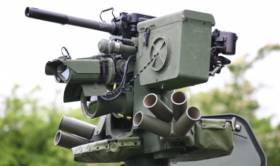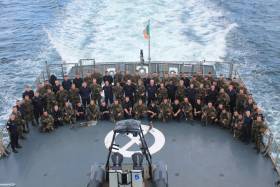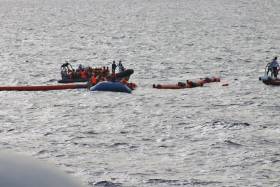Displaying items by tag: naval service
Naval Service Is A Sinking Ship With Staff Exodus
In the Irish Examiner's report today the number of sailors leaving the Naval Service paints a grim picture for the future of Ireland’s maritime armed service.
More than 100 members of the service are likely to leave this year alone, amounting to 10% of the force. PDForra, which represents enlisted personnel in the service, fears the number could be much higher.
Coming on top of resignations from the Army, the exodus of highly trained and experienced men and women should be of concern, in particular, to Leo Varadkar, in his dual role of Taoiseach and minister for defence.
For more click here for a link to the story.
Waterford welcomes the Naval Service’s newest offshore patrol vessel LÉ George Bernard Shaw for its official naming and commissioning ceremonies today, Tuesday 30 April.
Public viewing of the ceremonies will be from the William Vincent Wallace Plaza in the city centre.
LÉ George Bernard Shaw was delivered from the Babcock Marine Appledore shipyard in Devon to Cork Harbour last October.
It is the fourth and final ship of the P60 class commissioned over recent years, after LÉ William B Yeats, LÉ James Joyce and LÉ Samuel Beckett.
Volunteers Sought by Naval Service to Fill Gaps
#navy - Patrol ship captains of the Irish Naval Service are being forced to seek ‘volunteers’ to crew their vessels due to decreasing numbers available.
The Irish Examiner has learned the Naval Service is desperately trying to crew a nine-ship fleet with numbers which cannot service seven.
A common practice is emerging where personnel, assigned to specific ships, are being asked to fill gaps on other ships which primarily conduct fishery patrols. And, despite the shortage, the Government is still pressing ahead with plans to purchase a new ultra-modern multi-role vessel (MRV) which could cost up to €200m.
Chronic shortages, however, exist in many sections of the Naval Service. According to the Defence Forces, the minimum number of personnel required to run the Naval Service is 1,044.
But the official and latest figures show a total of 974 which includes 195 personnel engaged in professional qualification (PQ) training who cannot serve at sea. They include recruits and officer cadets who are undergoing basic training, technical trainees, and Ordinary to Able Rate (OARs) trainees.
Further reading on this crew-shortage story can be seen by clicking this link.
Recruitment in Naval Service Says PDforra Has Reached New Crisis Point
#navy - PDforra, the organisation representing enlisted personnel in the Defence Forces has said recruitment in the Naval Service has reached a new crisis point and the only way to solve it is with pay increases to retain personnel.
As BreakingNews reports, the latest figures obtained by PDforra show there were nearly 800 expressions of interest in the latest recruitment drive for the service.
However, PDforra president Mark Keane said that 50 were initially asked to attend for interviews and medical/fitness tests, but just six turned up to fill a recruit class that is supposed to be 48-strong.
He said on average nearly one-in-five inducted into recruit classes opt out before they are fully trained and more leave quickly afterwards because the pay is so poor.
For further reading on this story, click here.
Live Firing Practice Off South West Coast This Week
#MarineNotice - The Defence Forces will be conducting surface and air live firing practice shoots in Sea Area South South West (D13) between Seven Heads and Galley Head and to seaward between Tuesday 26 and Thursday 28 June from 8am to 6pm daily.
The danger area comprises the sea area contained within the co-ordinates detailed in Marine Notice No 27 of 2018, a PDF of which is available to read or download HERE.
While the range is active, this sea area is out of bounds to all vessels. A Naval Service patrol vessel will enforce the exclusion zone ‘D13’.
All vessels are required to remain outside of the exclusion zone while the range is active, and are also recommended to carefully monitor the radio navigation warnings that will be broadcast during the firing period.
#Navy - The Naval Service has posted to its Facebook page a remarkable video captured by drone of the LÉ William Butler Yeats carefully berthing in its home port at Haulbowline in Cork Harbour.
The €66 million vessel, which was formally commissioned into service in October 2016, can be seen being slowly but surely positioned by a small but powerful tug alongside a sister ship — the two Naval Service vessels almost kissing at the bow.
LÉ William Butler Yeats is the third of three newly commissioned navy ships, after leadship LÉ Samuel Beckett and LÉ James Joyce, constructed by Babcock Marine Appledore in Devon, UK.
The ship spent much of 2017 on humanitarian patrol in the Mediterranean, where the Government has pledged to send two Naval Service ships this year as part of the EU’s mission to rescue migrants and reduce people-smuggling.
Fire Crews Put Out Blaze At Haulbowline Navy Warehouse
#CorkHarbour - Independent.ie reports that firefighters have extinguished a blaze that broke out last night (Thursday 21 December) at the Naval Service base on Haulbowline Island.
The incident began around 9pm in a disused warehouse next to the officers’ mess and a number of other key buildings.
The fire quickly spread to the roof, where it could be seen across Cork Harbour.
Flames billowing out of the Naval Base in Cork Harbour @ralphriegel pic.twitter.com/645EQkXylx
— Darragh McGann (@McGannDarragh) December 21, 2017
All Naval Service personnel on base at the time were evacuated as a precaution and there were no casualties reported.
A fire last night in a disused building in our Naval Base, Haulbowline is now extinguished. An investigation will take place to establish cause. Thanks to our emergency service colleagues in #firebrigade, @GardaTraffic and our duty personnel for swift action to control the fire.
— Irish Defence Forces (@defenceforces) December 22, 2017
Marine Minister Michael Creed was on the other side of Haulbowline earlier this week to inspect remediation works on the East Tip waste site, as previously reported on Afloat.ie.
Recruits Required for Defence Forces But Amid Concerns Over Troop Numbers
#navy - A new recruitment competition has been opened by the Defence Forces writes The Irish Times, but this is amid concerns over dwindling troop numbers in the military.
Announcing the recruitment drive on Wednesday, Minister of State for Defence Paul Kehoe said the move “reflects the Government’s commitment to meeting the Permanent Defence Forces strength targets”.
A recent report commissioned by the Defence Forces found it is now at a “critical point” with staff numbers well below the target of 9,500.
The report, compiled by researchers at the University of Limerick, noted that figures for unit sizes were often embellished as the absence of members on leave, long-term training courses or overseas missions was not taken into account.
Mr Kehoe said previous recruitment campaigns will deliver more than 800 new Defence Forces personnel by the end of this year, although it is not known exactly how many new staff are proposed to be taken on as part of the latest wave.
“This general service recruitment campaign will build upon the successes of previous recruitment campaigns from which it is expected that just over 800 new personnel will have been inducted into the Permanent Defence Force by the end of 2017,” he said, adding: “As this will deplete existing panels, it is now appropriate that we initiate a new campaign in order to provide for the induction of further personnel in 2018.”
The newspaper has much on this story, to read click here and information on datelines for applicants wishing to join the Defence Forces including the Naval Service.
#Navy - A Naval Service seaman has expressed his gratitude to the Spanish coastguard for saving his life, after he fell ill while on humanitarian duty in the Mediterranean.
According to the Irish Examiner, Craig Clear was airlifted to Almeira from the deck of the LÉ William Butler Yeats on Tuesday (18 July) after suffering a collapsed lung and severed arteries.
But after two successful surgeries, the Co Laois man is in recovery — and on Wednesday he took to social media to share his gratitude to the helicopter rescue team from the Salvamento Maritimo.
The LÉ William Butler Yeats arrived in the Mediterranean on Monday (17 July) to take over from the returning LÉ Eithne, which is due in Cork Harbour today, as previously reported on Afloat.ie.
Naval Service Vessel Rescues More Migrants In Mediterranean
#Navy - The Naval Service’s LÉ Samuel Beckett assisted in rescuing 140 migrants from the Mediterranean off Libya this morning (Saturday 3 December), as The Irish Times reports.
Food, water and medical treatment were provided to the people who were transferred from their rubber boat to the rescue vessel MS Aquarius as part of the latest humanitarian operation in the region.
The operation comes just five days after the crew rescued more than 500 migrants from just four rubber vessels off Tripoli, as previously reported on Afloat.ie.
































